Beautiful, well-groomed lawn near the house - this picture pleases not only look. Emerald grass emphasizes architectural solutions, highlights flower beds, Rabata, Alpine slides. To make a lawn with your own hands, it is necessary not so much time, but to know how to do it correctly, it is necessary.
The basis of almost all lawns - grass. It has different species, with different characteristics, different color. In the context of the climate of the middle strip of Russia, not all of them feel well. Because if you are going to buy a ready mix, pay attention to the zoning: on the first wintering risks to lose the entire lawn.
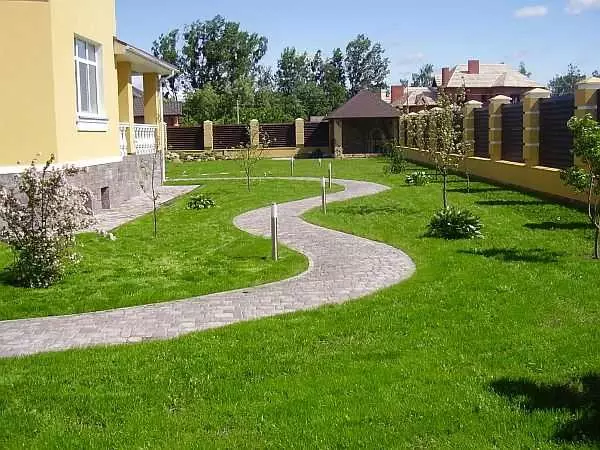
Green lawn with your own hands can be done in five to seven weeks
Especially careful need to be with a ricon. He quickly boils, creates a thick beautiful carpet, but it doesn't tolerate frost and in our climate will freeze. Buying a ready-made grass, look at her composition: the ricon should be a bit. If it gets freezing, it will not be much harm.
When sow grass
You can search for grass from May 1 to August 15. In the spring crop, the consumption of seeds on the square square increases slightly (by 10-15%). So you will quickly get a beautiful lawn and the fastener will go faster in the winter. Due to the high density of the plant will begin to compete with each other and weak will be ousted. Until autumn live only strong.When sowing in the summer, stick to the rate of consumption. Due to the lack of time, weak plants will not have time to force out, but everyone will be weakened by this struggle. Therefore, good care is important for summer lawns.
What is the best lawn grass
The most beautiful color and thick height of oatmeal and mint. Their greenery gentle and emerald. When creating a partent lawn, they are used by them. But for other types of lawns, for which they will not go, they cannot be used: they will quickly get off. On such lawns, it is more often sowing a field of different varieties. Not so gentle, it is well tolerate some degree of load.

The choice of lawn grass is wide, but most often five main:
For shadow lawns, oatmeal is more suitable. But even she will not grow in a deep and constant shadow. Sulti light - the base of photosynthesis. And at least some time the lawn should be covered.
Types of lawn
We are accustomed to the fact that the lawn is necessarily the grass covering the soil. It can be arranged flower beds, Rabata, Alpine slides and other decorative elements. This is not quite so. There are also at least three varieties of flowering lawns. They are undoubtedly more decorative, but walking on them is unlikely to succeed.Flowering lawns
Their base is cereals, but significantly "diluted" perennial or annual blooming plants. They are chosen so that the bloom has passed the entire season of vegetation - from mid-spring to late autumn. Depending on which plants are part of, there are three types of flowering lawns.
Meadow
Already by the name it is clear that the composition of the plants that can be seen on the present meadow. Only rarely in full and in a rigidly measured proportion. Traditional inhabitants of the meadow, like clover, chamomile, daisy, coins, millennium, yarrow and other blooming or decorative plants are added to the cereals. Despite the abundance of basic flowers - herbs.
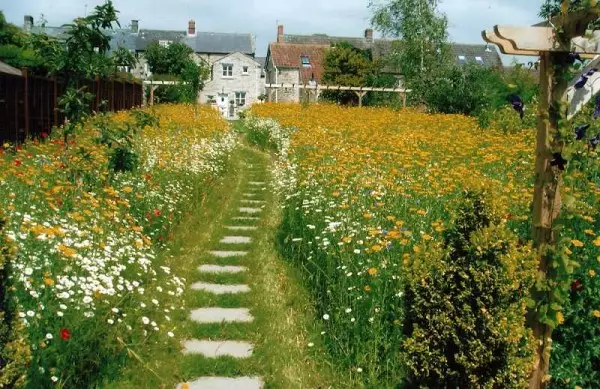
Meadow lawn is distinguished by high decorativeness. At different times, different plants bloom and the view is constantly changing, the palette changes
It is clear that you will not be able to mow such beauty, but one or twice the season for updating and rejuvenation you have to cut. Perennial plants, because with proper watering rapidly restore decorativeness. Saws around the whole area is not always appropriate, but some zones are very pleased.
Mauritanian
It is distinguished by the fact that flowers are used annuals. Therefore, such a lawn is not cut at all. The cereals pick down the lowest, their smaller than the colors. In Moorish lawn, flowers dominate. And in height and by quantity (see photos).
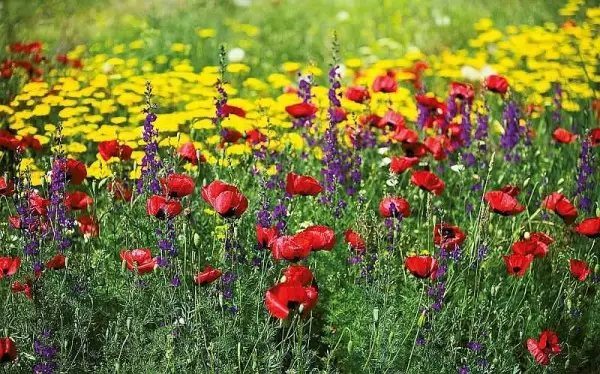
So the Mauritan lawn looks like - the riot of paints the whole season
They are selected so that the flowering is as long as possible. Usually as part of Mac-Samoki, Vasilek, Calendula, Matiola, Leng Color, Eshololization and other bright annuals.
Article on the topic: Beautiful hanger in a carriage tie with your own hands
Non-naughty
This is a completely unusual lawn according to the composition consisting of soil plants. Summit them into the open ground - the case is unpromising, growing seedlings - long, and buy ready - expensive. Therefore, a non-tax lawn is growing not one year and not two: plant plant in a small amount, waiting for them until they grow up. Such a lawn is the most difficult: the results of labor are visible only in a few years, but the efforts are worth it.
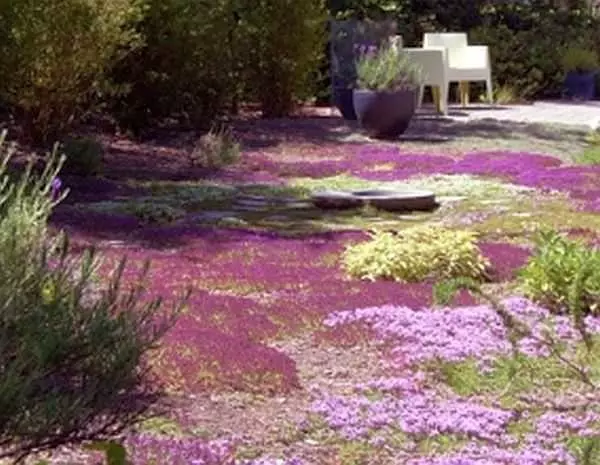
Non-frameing lawn - Ruisen made from soil surgery
Herbal lawns
In the view of a non-specialist, various types of lawns from the grass are almost the same: can slightly different color. But besides the different shade of greenery, they have different characteristics: one can go, according to others, it is contraindicated, a sowing rate is different, a different care is different. Naturally, different herbs with different characteristics are used.Ordinary
The most resistant to pull-out, on it can be walking. The herbs are selected with tough, coarsely cooked. But it is easier for him to care, it is less likely to pour out, some missions that do often are not visible with independent sowing. Ordinary lawn is an excellent choice for giving.
Parterial
This is one of the most decorative and front lawns. Differs in high decorativeness, herbs are selected gentle, beautiful colors. Herbage is low and thick, with proper care it looks just gorgeous. Such lawns are arranged in open places, but where no one will go there: too soft cereals will not stand such a load. Therefore, the parter lawn (see photos) is sown where only along the paths go.
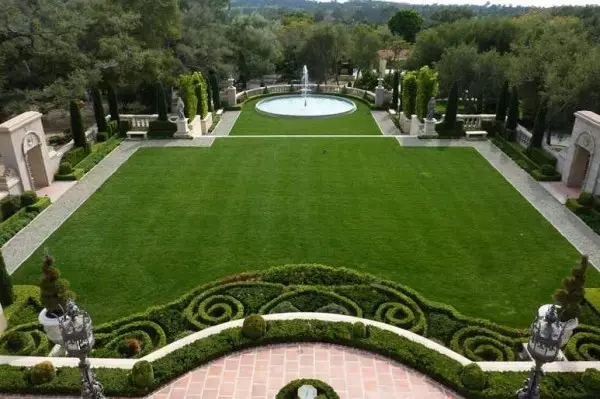
Parter's lawn is one of the most decorative and "elegant"
Special
Sit down on the slopes. As part of its herbs, having an extensive root system capable of keeping the soil from washing. The decorativeness of such a coating is medium, but it performs its main purpose well. A special lawn can be planted on the slope leading to the river or lake, if such is on your site.Sports
The mixture is more complicated - in addition to traditional grades of cereals, special, more resistant to abrasion. The decorativeness of the sports lawn is not the main characteristic, therefore even well-groomed, it looks much worse than the ordinary and, moreover, the partner. But it has a very high resistance to abrasion.
Due to the use of special herbs, its value is higher, harder to care. Therefore, to sow such a mixture are those zones that will be actively operated: the playground for games, the zone where they will actively walk - near the gazebo, playground, swing. The rest of the area is most often discharged to an ordinary lawn.
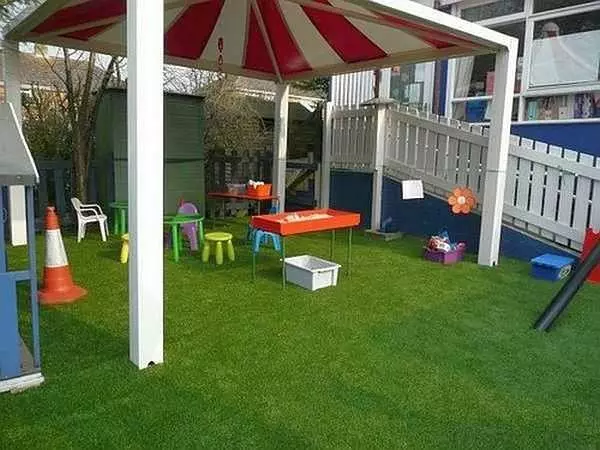
On the children's or playground is better to sow sports lawn
Natural
For this type of coating, mixtures are not bought, do not conduct any work. Just cut those herbs that are. Most often, the natural lawn leaves in the garden: it protects the soil from drying well, and the requirements for decorativeness here are not very high. Too large plants that do not fit into the desired picture are deleted manually. The rest in the process of haircuts are becoming smaller, forming a turin of different colors.How to make a beautiful lawn
The growing of the lawn consists of several stages:
- The preparation of the soil is the removal of weeds, if necessary, adjust the acidity and increase in fertility.
- Sowing grass, regular watering.
- First haircut. It is carried out after the grass will reach a certain size.
- Regular care and periodic haircut.
In the process, you will have to follow the humidity of the soil and timely remove weeds, time from time to time to feed, hurry up properly, which may appear after the breathtaking summer or too harsh winter. This is brief, all the technology of growing lawn, and then in detail on points.
Preparation of soil
The first thing to be done is to evaluate soil fertility. If the ground clay or loam, the grass will not grow normally on it. You will have to carry out serious soil preparation. There are two options: fall asleep the area from top view of fertile soil or remove the soil and to fall asleep the earth into the resulting kitty.
It is easier, naturally just fall asleep, but it is not always possible to realize: the layer of the Earth in this case should be about 20 cm. Raising the lawn for such height - not the most reasonable solution: There will be problems with water allocation, high well-fortified borders are required, and external The view is strange. Therefore, clay soils are often removed to a depth of 15-20 cm, and then the land will be taken into the resulting pit.
If you have chosen the second option, you can sit geotextiles on the bottom of the bottom. He will not give to germinate through it, and you will not have problems with weeding.
Article on the topic: Gas column water assembly
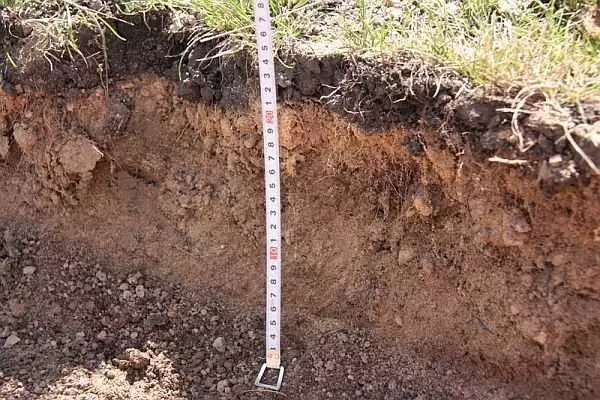
The soil is removed to a depth of 20-25 cm, and then falls asleep
If the soil is normal, the preparation of the soil under the lawn grass is not so complicated. First remove all weeds. This can be done with mechanical chopping and / or hands, you can use herbicides. They are bred according to the instructions, water the place of the future lawn. After a few days, the vegetation is yellow and dry out, it is removed. Simultaneously with weeds, they remove stones, roots, other fragments that can interfere with the growth of the horse system.
The next step is to check the soil acidity. Almost all herbs included in lawn blends grow well on neutral soils. If you want to have a beautiful lawn, you will have to adjust its acidity. Therefore, in the store for gardeners and gardeners, find a set to determine the acidity of the soil and check which soil on your site. It is just a Lacmus paper that needs to be put on the soil, wait until it is painted and on the color chart existing on the packaging, determine the acidity of your soil. If the soil is acidic, add lime if alkaline reaction - scatter the crushed peat. Next step by step. Simultaneously with loosening, remove those stones and the roots that will get out.
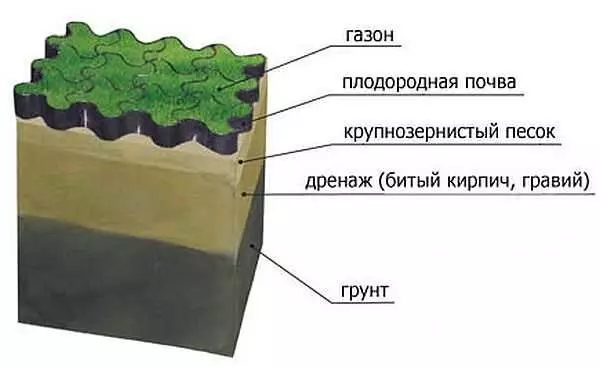
On wetlands in order to grow a beautiful lawn, it is necessary to create normal conditions for water removal
The next step is the addition of a fertile layer. A fertile loose and light soil is called and is distributed throughout the plot with a flat layer of 6-10 cm thick. The layer is spacing first with shovels, then robbles. At the same time, it is desirable to form a light bias towards the fence: so you will not have problems with the transmission of the lawn in the shower: water will be drained from the site. Blind make minimal - 1 cm per meter or one and a half. This is quite enough to ensure the outflow of water, and it will not be noticeably noticeable.
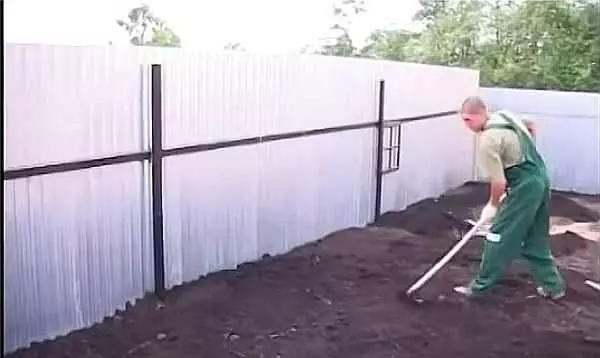
Soil preparation for lawn - River rake
One Council: Bridal Earth contains roots, stones, branches, etc. To remove them, it is sifted through a large grid (as they do during construction when sand is sieved). And the sifted is already delivered over the site.
The next step in the arrangement of the lawn with your own hands is a rambling or tool. It allows you to compact the soil, and when a person does not occupy a lawn, the soil under the foot is not presented, but remains smooth. Also, this process allows you to identify irregularities that will necessarily appear as a result of all land works.
If there is no special rink, it can be made from a piece of asbestos or iron pipe. Inside the pipes, they make the rod, cling to it the handles (even just tied the rope). You made everything rink for lawn with your own hands. Now it is dragging it on the site, the rambling the soil until it can not fall on it.
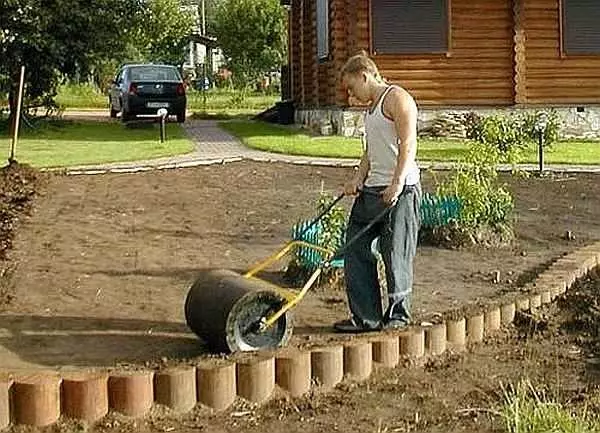
Radio Radine - an important stage that allows you to reveal irregularities. To do this, use a lawn roller (or make it from a pipe, barrels)
With a radius of the lawn, pants and pits will be shown. From the humps of surplus removing, we fall asleep pits. Aligning so the surface, we take the gasket and pass the plot again. To get a perfectly smooth surface, you can take a long board and stretch it together along the plot, cutting off the face of irregularities. Or make a device from two boards - as in the photo below. They can work alone.
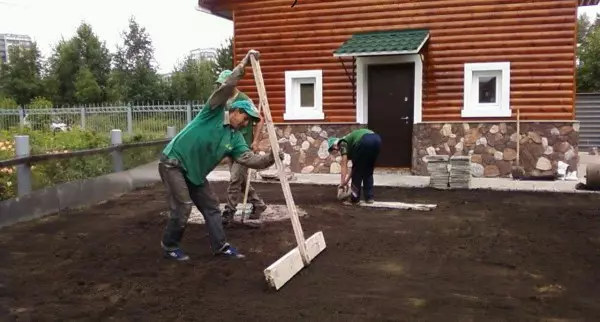
Preparation of a plot under the lawn turns into a thorough alignment of the soil
Making fertilizers
You can make fertilizers at several stages (one of them). In principle, if you are on top to normal soil, pour 6-10 cm imported, fertilizer can not be used. But for more active growth - you can add:- After the imported soil has been scattered over the site and before aligning with robbles;
- If fertilizers are used in dry form, you can mix them with seeds;
- Dilute and pour the soil.
The most optimal way is watering. It guarantees a more even distribution of nutrients. But with this way, rarely who wants to bother himself, except for an automatic irrigation system. The remaining two are equivalent. It is more convenient to make together with the seeds: it takes less time.
Squeeze grass
Previously, it is necessary to break the rammed land slightly rumble. Just walk light robbles, slightly shry up the top layer. Now you can save grass.
Buy a seeder that costs about $ 200-300 for one-time application is unlikely reasonable, therefore you spend the seeds for the lawn in the bucket, and the old Dedovsky method is scattered on the surface: take a handful and skipping gradually through your fingers, scatter more or less evenly. Those who wish at least some mechanization, you can offer two options for the simplest seeders for lawn grass, which are easy to make with your own hands. This is a tin or plastic bottle in which holes made holes (see photo).
Article on the topic: Assembling the cabinets under the sink do it yourself
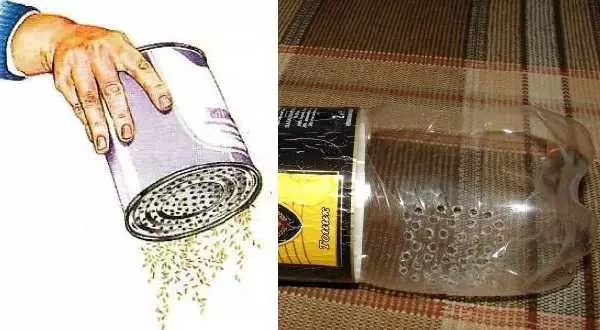
Homemade Sewer for Lawn
So that it does not work so that in one corner thick, and in the other - empty, preferably a plot and seeds are divided into parts. Seed consumption is specified for each mixture. What is the area of the sowing site, you can estimate in place and measure the amount that you need to scatter. For those who make the lawn in the country with their own hands for the first time, it is better to divide the measured quantity into two equal parts and pass the site first along, and then across. So the seeds will be distributed more evenly.
After sowing, seeds need to close the Earth. For this there are two ways:
- Going around the site by rake, trying to pour out the seeds of the earth. This method is less reliable - many remain outside, poultry scream them, and the germination worsens.
- From above sprinkled with the remnants of the land. The layer is 3-5 mm. All seeds are covered with the ground, are in the best conditions, shoots are better.
On this we can assume that you made the lawn with your own hands. It remains to water and wait for gear.
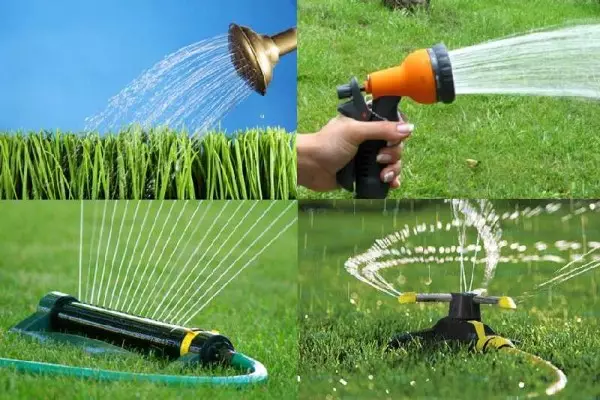
Razon watering devices that can be bought in the store
Watering and waiting
It is necessary to water the lawn depending on the conditions: the soil should not dispel, but also should not be very wet. Water should not beat a big jet, there should be no stream or puddle. Stream break into small jetings: Install the sprinkler or raincoat if you water the manual on the hose to the nozzle. In the photo above you will see several options that will help solve the problem of watering. They are sold in stores.
There are also a few homemade variants of sprinklers for watering lawn. In most of them, this is a plastic bottle with holes done in it connected with a watering hose. She can lie and irrigate the surrounding area. If the pressure in the system is enough, you can bind it to the column. In this case, the area of watering will be greater. Splashes for watering the lawn do it yourself very simple. Look at the photo.
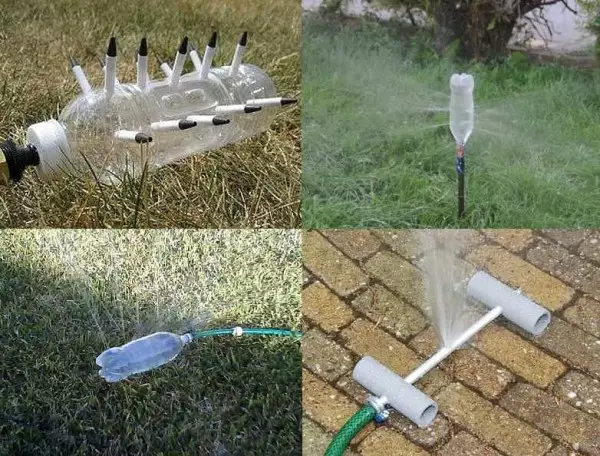
Sprinklers for watering the lawn with their own hands from bottles is easy: take a bottle, split the nail, do holes (diameter is selected by an experimental way, but start with small)
Another way to get small splashes: in the segment of the plastic pipe to do holes or make a thin cut. It is necessary or thin jets, or a fan (in the photo on the right below).
Why do water need to sprinkle? Because for the normal development of the root system, the soil must be wet (but not wet) to a depth of about 6-10 cm. If it is simply filled from above, it will be only worse: the water displaces oxygen and the roots have nothing to breathe. So splashing or drip irrigation is the best way to watering the lawn.
Seven or ten days the first shoots appear. They are still rare, but do not be upset. Just jammed only the seeds of some varieties, whose shoots appear quickly. The rest germinate later. With proper care after 20-30 days, the height of the herbage reaches 10-15 cm. At this time, the first deficiency must be carried out. Leave for the first time about 5 cm of height. With such a height, the grass will grow actively. After another 10-12 days, it will again be a height of about 12 cm. Now you can crop the grass shorter - leaving 3-3.5 cm.
How to care for lawn grass
The main care is timely watering, weed removal and periodic haircut. If you watered to sprinkle, in the soil there will be enough oxygen and plants should develop normally.

How to check how much water gets your grass
Problems with disadvantage of oxygen may occur after long-standing heavy rainstones when water is puddles on the plot or irregular watering with the same result. Then the aeration of lawn is necessary. To do this, use a rink similar to the one that was used during the tillage of the soil, but there is an island that skews the turf. Through these punctures, oxygen enters the soil, the plants begin to grow better.
